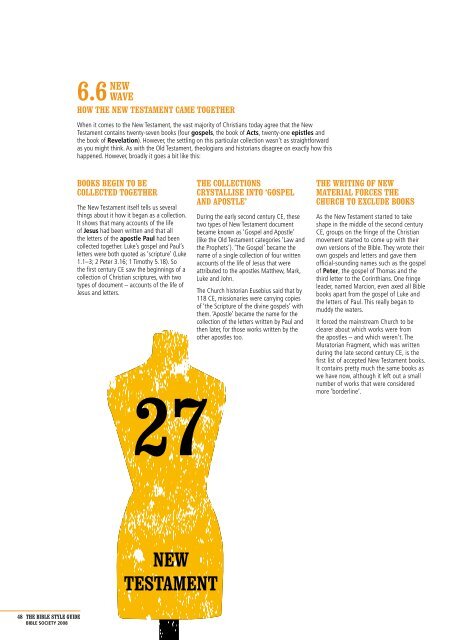BiBle STyle Guide - Get a Free Blog
BiBle STyle Guide - Get a Free Blog
BiBle STyle Guide - Get a Free Blog
Create successful ePaper yourself
Turn your PDF publications into a flip-book with our unique Google optimized e-Paper software.
48 The <strong>BiBle</strong> <strong>STyle</strong> <strong>Guide</strong><br />
bible society 2008<br />
6.6 new<br />
wave<br />
how the new testament came together<br />
When it comes to the New Testament, the vast majority of Christians today agree that the New<br />
Testament contains twenty-seven books (four gospels, the book of Acts, twenty-one epistles and<br />
the book of Revelation). However, the settling on this particular collection wasn’t as straightforward<br />
as you might think. As with the Old Testament, theologians and historians disagree on exactly how this<br />
happened. However, broadly it goes a bit like this:<br />
Books Begin to Be<br />
collected together<br />
The New Testament itself tells us several<br />
things about it how it began as a collection.<br />
It shows that many accounts of the life<br />
of Jesus had been written and that all<br />
the letters of the apostle Paul had been<br />
collected together. Luke’s gospel and Paul’s<br />
letters were both quoted as ‘scripture’ (Luke<br />
1.1–3; 2 Peter 3.16; 1 Timothy 5.18). So<br />
the first century CE saw the beginnings of a<br />
collection of Christian scriptures, with two<br />
types of document – accounts of the life of<br />
Jesus and letters.<br />
27<br />
new<br />
testament<br />
the collections<br />
crystallise into ‘gospel<br />
and apostle’<br />
During the early second century CE, these<br />
two types of New Testament document<br />
became known as ‘Gospel and Apostle’<br />
(like the Old Testament categories ‘Law and<br />
the Prophets’). ‘The Gospel’ became the<br />
name of a single collection of four written<br />
accounts of the life of Jesus that were<br />
attributed to the apostles Matthew, Mark,<br />
Luke and John.<br />
The Church historian Eusebius said that by<br />
118 CE, missionaries were carrying copies<br />
of ‘the Scripture of the divine gospels’ with<br />
them. ‘Apostle’ became the name for the<br />
collection of the letters written by Paul and<br />
then later, for those works written by the<br />
other apostles too.<br />
the writing of new<br />
material forces the<br />
chUrch to exclUde Books<br />
As the New Testament started to take<br />
shape in the middle of the second century<br />
CE, groups on the fringe of the Christian<br />
movement started to come up with their<br />
own versions of the Bible. They wrote their<br />
own gospels and letters and gave them<br />
official-sounding names such as the gospel<br />
of Peter, the gospel of Thomas and the<br />
third letter to the Corinthians. One fringe<br />
leader, named Marcion, even axed all Bible<br />
books apart from the gospel of Luke and<br />
the letters of Paul. This really began to<br />
muddy the waters.<br />
It forced the mainstream Church to be<br />
clearer about which works were from<br />
the apostles – and which weren’t. The<br />
Muratorian Fragment, which was written<br />
during the late second century CE, is the<br />
first list of accepted New Testament books.<br />
It contains pretty much the same books as<br />
we have now, although it left out a small<br />
number of works that were considered<br />
more ‘borderline’.


